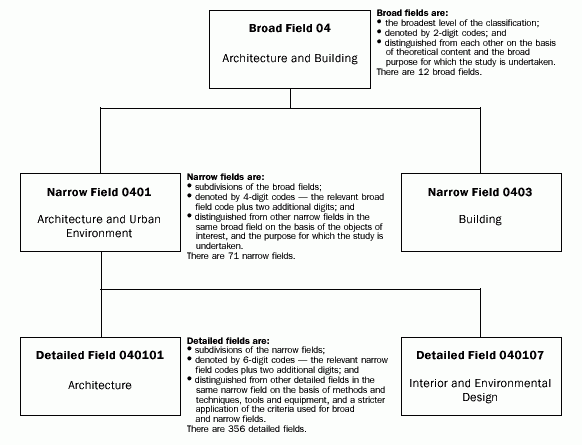Field of Education
Classification Structure
Broad fields
Broad fields are:
- the broadest categories of the classification;
- denoted by 2-digit codes; and
- distinguished from each other on the basis of theoretical content and the broad purpose for which the study is undertaken.
There are 12 broad fields.
Narrow fields
Narrow fields are:
- subdivisions of the broad fields;
- denoted by 4-digit codes - the relevant broad field code plus two additional digits; and
- distinguished from other narrow fields in the same broad field on the basis of the objects of interest, and the purpose for which the study is undertaken.
There are 71 narrow fields.
Detailed fields
Detailed fields are:
- subdivisions of the narrow fields;
- denoted by 6-digit codes - the relevant narrow field code plus two additional digits; and
- distinguished from other detailed fields in the same narrow field on the basis of methods and techniques, tools and equipment, and a stricter application of the criteria used for broad and narrow fields.
There are 356 detailed fields.
Residual categories
Codes ending in “99” are allocated to fields of education which may belong to a particular broad or narrow field of education but which do not represent sufficient observations to be a distinct detailed field of education in their own right. These are the “other” or “not elsewhere classified” (n.e.c.) categories. These categories should not be used to code responses which are inadequately described or ambiguous.
Supplementary codes
Supplementary codes for field of education are:
- 6-digit codes ending in two or four zeros; and
- codes commencing with two or more zeros.
Codes ending in two or four zeros are described as “not further defined” (n.f.d.) codes and are used to assign Field of Education codes to responses to questions in statistical or administrative data collections which cannot be coded to any specific detailed field in the classification but can be coded to a higher level of the classification structure.
For example if the Field of Education is given as “law” it is not possible to identify which of the seven detailed categories of Law it should be coded to, but it can be coded to Narrow Field 0909 Law and would therefore be assigned the 6-digit code of 090900 Law, n.f.d. Similarly, responses which do not contain sufficient information to be related directly to a particular narrow field category but which are known to be within the range of a particular broad field are coded to that broad field. For example, if the Field of Education is given as “health” it can be coded to Broad Field 06 Health and allocated the code 060000 Health, n.f.d.
Codes commencing with two or more zeros are used to process responses which do not provide sufficient information to be coded to any field of the structure and when there is no field of education given. Other codes commencing with zero may be defined by users to facilitate the processing and storage of data, when data sets coded to ASCED contain records for entities outside the scope of ASCED. For example, these codes might be used for educational activities that are excluded from ASCED (e.g. hobby/recreational programmes).
Format of the definitions
This publication contains definitions for the broad, narrow, and detailed fields. The format of the definitions may vary between the hierarchical levels, but all contain similar elements.
The features of the broad, narrow and detailed field definitions are:
- a lead statement which describes the theoretical orientation of the programme;
- main purpose (not applicable for detailed field);
- skills learnt/theoretical content/subjects undertaken;
- a list of lower level fields contained in the field (not applicable for detailed field); and
- a list of inclusions or exclusions (as necessary).
Profile of the Field of Education structure
The structure of ASCED Field of Education has three levels:
- broad field;
- narrow field; and
- detailed field.
The following is an illustration of a representative part of the Field of Education structure:
Illustration of a representative part of the Field of Education structure.
Image
